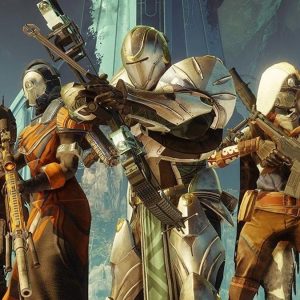[ad_1]
. The last major addition, titled Next, had added so much in one go that it had left him a little exhausted, and he wanted to switch to smaller, more regular patches. For a while, he kept that promise to himself. “We kept things more as a live game, like a normal studio would,” he tells me. “We were doing really well, like a proper game!”“And then we just went mad.”
13 months after Next’s release, we’re sat in the same office, and Murray is showing me a new mega-update called Beyond. It’s considerably bigger than Next, rolling three planned sets of changes into one package. The free update will be out on August 14, and is built with the kind of altruistic optimism we’ve come to expect from Hello Games, designed to simultaneously offer meaningful changes to existing players, tempt lapsed players back, and offer brand new experiences for those who haven’t yet been converted.
Here’s everything coming in Beyond, split up into their three main categories. Sit back, this might take a while.

No Man’s Sky VR
Hello did not take an easy route with No Man’s Sky VR. It’ll be supported on PSVR (with extra power provided to those with a PS4 Pro), Oculus, Vive and Index. You can control the VR version of the game using controllers, knuckles, wands, Oculus Touch, PlayStation Move and DualShock 4. There are dozens of control schemes (and yes, you can choose between teleporting or walking normally) and new UI screens. Everything that can be done in the base game can be done in VR, meaning you can also join non-VR players with no restrictions (other than them not being able to fist-bump you). It is absolutely not as simple as letting you control your character’s head directly.
Of the three pillars of Beyond, it’s by far the most tangible set of changes – strapping on an Index and looking around No Man’s Sky’s neon-hued worlds is fantastic, and taking off in the cockpit of your ship is better, but even seasoned players will require some retraining to get used to it all. Controls are fundamentally different, from activating your analysis visor by tapping the side of your head, to navigating menus by physically prodding at holographic displays that wink into existence out of the back of your space-gloves. Once you are used to it, it’s remarkably intuitive – I make a joke about wanting to be able to just punch the carbon out of an alien plant instead of using my mining laser, and a developer tells me to try it. It works.

That interactivity is key. VR in No Man’s Sky isn’t a gimmick for just looking at pretty things. Instead, it’s a full third perspective in which to play the game, alongside third-person and first-person TV views – and with all the attendant changes that takes to develop. Just like those modes, you might switch between them at a whim, just for a change of pace (or, let’s face it, to stop sweating up your VR headset). That you have that option, and that it’s such a viable one, is Hello’s real achievement here.
No Man’s Sky Online
No Man’s Sky got a (very good) multiplayer system last year, turning it into a far more recognisably “online” game than it had been previously. But clearly it wasn’t online enough for Hello Games. Murray points out that, right now, only around 10-20% of players play the game as a multiplayer experience, and very much wants that to change.
Central to that is the Nexus, a new social space that can summoned, without an apparent loading time, into any system you’re in. A space station lobby of sorts, the Nexus will be filled with 16-32 other players (dependant on platform, with that upper limit being for PC), picked from your online friends and random strangers. It will include new shops, new missions, even new story elements – the Nexus, it turns out, is a ship belonging to Polo and Nada, who longtime players will recognise immediately. It’s been designed to help players show off their creativity, from their ships to their bases – aided by a teleporter that will allow players to visit your planetary creations, and will even allow Hello Games to feature its favourites.
Murray’s at pains to say that No Man’s Sky isn’t becoming an MMO, but he has a useful alternative touchstone – Destiny. Apart from Murray constantly saying that Hello has added “fireteams” when the game calls them “groups”, there are other comparisons. The Nexus acts as No Man’s Sky’s version of The Tower, for instance, but, on a broader level, this game is also nabbing Destiny’s gentle sway from lonely play to co-op with strangers. If you land on a planet other players are exploring, they’ll just be there. If there’s a community event on a specific planet, that 16-32 player limit will still be in effect, making things a touch more crowded than we’re used to from NMS. If you want to head out together, you can organically make a fireteam – sorry, group – in the Nexus, take a new multiplayer mission, and exit into the same system with little to no fuss.
It’s less of a fundamental change than Next’s multiplayer additions, but it might have a more fundamental effect – making it so much easier to meet and work with other players should increase how much you want to play with them.
No Man’s Sky Version 2.0
The final, most mysterious pillar of this update is actually a stack of smaller updates – so many, in fact, that Hello Games is choosing to take the step of upping No Man’s Sky’s version number. As a marker of the size of this undertaking, Murray tells me to look at the changelist for the Next update. It’s long, comprised of almost 250 bulletpoints’ worth of tweaks and additions. Beyond’s list is, apparently, almost twice as long.
The idea here is that Beyond shouldn’t just represent an enticement to potential new players, but sate those who’ve already played for hundreds, even thousands of hours. Their requests might be smaller in scope than the two other pillars, but are made more meaningful by the sheer weight of time played – if you’ve had a little issue with the game, Hello Games hopes to have fixed it by Beyond.
That community-focused approach to fixes and additions is why, at first glance, the slice of Beyond’s changelist I’m shown is almost hilariously varied. There’s the fundamental stuff: a new Galactic Map, brand new alien races, more accessibility options. There’s also some small-scale, very specific stuff: chairs can now be sat in, NPCs actually walk around, there are recipes to make (although we’re not told for what). And then there are the oddities, the kinds of things that only truly long-time players would think to ask for, like how alien creatures can now be ridden, farmed or, er, milked.

One of the most exciting elements is the expansion of base-building, not only allowing you to make bigger, but more complex structures. There are industrial elements for automating resource production, not to mention logic pieces that will allow you build ‘smart’ structures, not unlike Minecraft’s redstone. When I walk into Hello Games’ gameplay room, a group of devs is playing a version of Rocket League they’ve built on an abandoned moon. It’s clearly pretty malleable.
The 2.0 changes are by far the least starry of Beyond’s three facets, but I think they’re probably the most significant. As Murray puts it: “It’s just a lot of stuff, and we wanted to get that across. Some people will say ‘oh well, online isn’t for me’, or ‘oh well, VR isn’t for me,’ or ‘VR and online isn’t for me’. But even then, we still have more stuff for them.”
I tell Murray it sounds like he’s been busy again. He emits something like a laugh living inside a sigh: “Too busy”. Somehow, I don’t think he’s going to slow down.
Joe Skrebels is IGN’s UK Deputy Editor, and VR finally allows him to live out his sci-fi truth – running around hostile planets waving his arms around and screaming. Follow him on Twitter.
[ad_2]
Source link

























